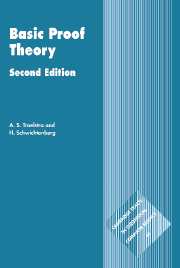Book contents
- Frontmatter
- Contents
- Preface
- 1 Introduction
- 2 N-systems and H-systems
- 3 Gentzen systems
- 4 Cut elimination with applications
- 5 Bounds and permutations
- 6 Normalization for natural deduction
- 7 Resolution
- 8 Categorical logic
- 9 Modal and linear logic
- 10 Proof theory of arithmetic
- 11 Second-order logic
- Solutions to selected exercises
- Bibliography
- Symbols and notations
- Index
1 - Introduction
Published online by Cambridge University Press: 05 June 2012
- Frontmatter
- Contents
- Preface
- 1 Introduction
- 2 N-systems and H-systems
- 3 Gentzen systems
- 4 Cut elimination with applications
- 5 Bounds and permutations
- 6 Normalization for natural deduction
- 7 Resolution
- 8 Categorical logic
- 9 Modal and linear logic
- 10 Proof theory of arithmetic
- 11 Second-order logic
- Solutions to selected exercises
- Bibliography
- Symbols and notations
- Index
Summary
Proof theory may be roughly divided into two parts: structural proof theory and interpretational proof theory. Structural proof theory is based on a combinatorial analysis of the structure of formal proofs; the central methods are cut elimination and normalization.
In interpretational proof theory, the tools are (often semantically motivated) syntactical translations of one formal theory into another. We shall encounter examples of such translations in this book, such as the Gödel-Gentzen embedding of classical logic into minimal logic (2.3), and the modal embedding of intuitionistic logic into the modal logic S4 (9.2). Other wellknown examples from the literature are the formalized version of Kleene's realizability for intuitionistic arithmetic and Gödel's Dialectica interpretation (see, for example, Troelstra [1973]).
The present text is concerned with the more basic parts of structural proof theory. In the first part of this text (chapters 2–7) we study several formalizations of standard logics. “Standard logics”, in this text, means minimal, intuitionistic and classical first-order predicate logic. Chapter 8 describes the connection between cartesian closed categories and minimal conjunctionimplication logic; this serves as an example of the applications of proof theory in category theory. Chapter 9 illustrates the extension to other logics (namely the modal logic S4 and linear logic) of the techniques introduced before in the study of standard logics. The final two chapters deal with first-order arithmetic and second-order logic respectively.
- Type
- Chapter
- Information
- Basic Proof Theory , pp. 1 - 34Publisher: Cambridge University PressPrint publication year: 2000

